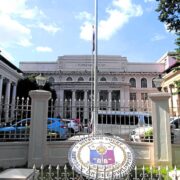Intramuros in archival memory

When I started exploring Intramuros on foot in the 1980s, it was undergoing the early phase of “beautification.” I was first drawn to “Plaza Sampalukan,” where tamarind trees grew. The story behind the plaza was gripping: a 17th-century crime of passion committed by no less than the Spanish governor general, Excmo. Sr. Don Alonso Fajardo de Tenza, who served from 1618 until his death from depression in 1624. The victims were his ill-fated wife, Catalina Zambrano, whom he caught with her lover, Juan de Messa Suero—an ex-Jesuit who had collected three wives before he turned 30. The details are in the archival record: the governor finds his wife in the house of Juan de Messa; he stabbed him dead, then stabbed his wife repeatedly until she made a deathbed request for confession he could not refuse. After confession, she was finished off. The corpses of the victims were displayed in the courtyard of San Agustin Church for all to see.
Juan de Messa’s house was razed to the ground, salt sprinkled on the soil so that nothing would ever stand or grow on the site. But then tamarind trees grew, hence the name Plaza Sampalukan. Today, a memorial to the 100,000 casualties of the so-called 1945 “Liberation of Manila” stands there, a testament to noncombatants slaughtered by the frenzied Japanese Army and American shelling that leveled Intramuros to the ground. Thanks to the late Carmen Guerrero Nakpil, the former “Liberation of Manila” is now commemorated as the 1945 Battle for Manila.
A few weeks ago, I delivered a lecture not so much about the human casualties of the World War II, but about the cultural casualties of the war: built heritage, paintings, sculptures, monuments, libraries, books, archives, and documents. Like human lives, these are irreplaceable. Japanese Admiral Sanji Iwabuchi disobeyed higher orders to leave Manila, but turned the city into a fortress with booby traps and kill zones. In the face of defeat, Japanese soldiers killed and destroyed wantonly; they did not spare noncombatants: women, children, the old, and the infirm. The classical Legislative Building, which housed the National Museum and National Library, was destroyed. But contrary to popular belief, the rare books and manuscripts from the National Library were transferred to vaults at the Manila City Hall and the Philippine Normal School building, and survived. Previous estimates that 95 percent of the collection was lost or destroyed are, fortunately, an exaggeration. Manuscripts in the hand of Jose Rizal, including the originals of “Noli Me Tangere,” “El Filibusterismo,” and “Mi Ultimo Adios,” are still extant. Much of the former Tabacalera Collection, which includes samples of early Philippine printing or “incunabula” printed in Manila and nearby towns from 1492 to 1542, is still around to serve research, enjoyment, and inspiration to scholars and interested general readers alike.
A pity that the University of the Philippines Library on Taft Avenue, where the Supreme Court now stands, was described as “completely ruined,” with an estimated 2 percent of its collections that survived. My mentors, the historian Teodoro A. Agoncillo and the anthropologist E. Arsenio Manuel, waxed nostalgic about their youthful reading in the stacks of the UP Library Filipiniana section. When war broke out in 1941, they brought the core of their personalities to UP for safekeeping. They assumed that the invading Japanese Army would respect and spare the university, only to find out that their books ended up in a bonfire.
Of the eight famous churches in Intramuros, only San Agustin Church was left standing after 1945. Other buildings, like the Manila Cathedral and the Ayuntamiento, are postwar reconstructions of sites and structures that only remain in memory, archival records, and prewar photographs. Looking at postwar pictures of the remains of Spanish Manila, I noted that significant parts of many of the historical churches were still smoldering in March 1945. A pity these were not preserved and made part of postwar reconstruction, but it must have been easier to raze everything to the ground and build from the ground up. Heritage wasn’t a priority for the Roxas government, faced with the task of rebuilding a broken nation.
Of the other Intramuros churches, those that remain in memory are: the Romanesque, Gothic, and Mission-style Santo Domingo Church, originally built in 1857. The neoclassical San Ignacio Church, built from 1878 to 1889, with fabulous wood carvings by Tampingco, is also gone. It is now the Intramuros Information Center and Museum. San Nicolas de Tolentino Church, built in 1881, was abandoned by the Recollects, who relocated outside the walled city. The same for Lourdes Church, built in 1891, which witnessed the massacre of Capuchins by the Japanese. San Francisco Church, built in 1739, was Baroque in design; on its ruins grew Mapua University. A statue of St. Anthony of Padua, which survived the war, now stands in the Santuario de San Antonio in Forbes Park. The Monasterio de Santa Clara, built in 1621, probably as atonement by Fajardo, whose story opened today’s column, moved to Quezon City. It remains the place to offer eggs for good weather.
Intramuros remains in memory and the archive.
—————-
Comments are welcome at aocampo@ateneo.edu
Ambeth is a Public Historian whose research covers 19th century Philippines: its art, culture, and the people who figure in the birth of the nation. Professor and former Chair, Department of History, Ateneo de Manila University, he writes a widely-read editorial page column for the Philippine Daily Inquirer, and has published over 30 books—the most recent being: Martial Law: Looking Back 15 (Anvil, 2021) and Yaman: History and Heritage in Philippine Money (Bangko Sentral ng Pilipinas, 2021).


















When plastic treaty fails, can citizens fill the gap?